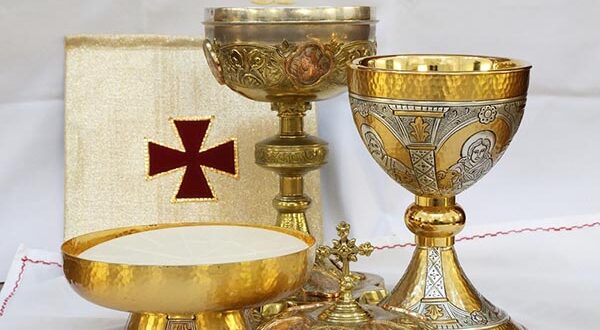The Catholic liturgy, considered “the source and summit of the Christian life” (Sacrosanctum Concilium, 10), is filled with symbols, gestures, and elements that immerse us in the mystery of God. Among these elements, sacred vessels hold a special place, as they are entrusted with containing and safeguarding the Body and Blood of Christ, the greatest treasure of our faith. In this article, we will delve deeply into the theological significance, characteristics, and relevance of sacred vessels in the liturgy, as well as their importance in the daily life of the faithful.
What are Sacred Vessels and Why Are They Important?
Sacred vessels are the containers used in the Eucharist to consecrate, hold, and distribute the Body and Blood of Christ. The primary sacred vessels include the chalice, paten, ciborium, monstrance, and pyx. Each has a specific purpose, but they all share a common aim: the worship and adoration of Jesus present in the Eucharist.
The importance of sacred vessels lies not only in their practical function but also in what they represent: the dignity and reverence owed to the mystery of transubstantiation, where the bread and wine become the Body and Blood of Christ. Their design, care, and use reflect the Church’s reverence for the Sacrament and the centrality of the Eucharist in Christian life.
The Principal Sacred Vessels: Meaning and Function
- The Chalice
The chalice is the vessel used to hold the wine that will become the Blood of Christ. Its shape and material are regulated by Church norms, as it must be noble and dignified, a visible sign of the sacredness of its contents. Since the early centuries, the chalice has symbolized Christ’s sacrifice on the cross and His total self-gift out of love for humanity. For the faithful, the chalice is a reminder that we are called to participate in Christ’s sacrifice, offering our own lives as “a living sacrifice, holy and pleasing to God” (cf. Rom 12:1). - The Paten
The paten is the small plate used to hold the bread that will be consecrated. Its use emphasizes the uniqueness of Christ’s Body and its distribution to the faithful as spiritual nourishment. Like the chalice, it must be made of precious materials, as a sign of reverence. - The Ciborium and Pyx
These vessels are used to store and transport consecrated hosts, especially for bringing Communion to the sick and those unable to attend Mass. Their existence reminds us of the Church’s mission to bring Christ to every corner of the world, especially to those in need. - The Monstrance or Ostensorium
The monstrance is used to expose the Blessed Sacrament for Eucharistic adoration. Its often elaborate and radiant design directs attention to Christ present in the consecrated host. This sacred vessel invites us to contemplate the mystery of the Eucharist and deepen our personal relationship with Jesus.
The Formation of Priests and the Eucharist
Before being ordained, a Catholic priest undergoes extensive formation that encompasses several dimensions: spiritual, pastoral, intellectual, and human. During their years in seminary, future priests study sacramental theology, liturgy, and Eucharistic doctrine, among other subjects, to fully grasp the greatness of the mystery they will celebrate. They also receive spiritual formation so that their lives may bear witness to the Eucharistic sacrifice they renew at every Mass.
A key aspect of priestly formation is cultivating the ars celebrandi, or the art of celebrating the liturgy with reverence, dignity, and devotion. This includes knowledge of and proper use of sacred vessels, as a visible expression of the holiness of the liturgical act.
Practical Applications for the Faithful
While sacred vessels are primarily used by priests, the faithful are also called to reflect on their meaning and actively participate in reverence for the Eucharist. Here are some practical ways to do so:
- Foster Eucharistic Adoration
Adoring the Blessed Sacrament is an opportunity to deepen our relationship with Christ and recognize His real presence. As we contemplate Jesus in the monstrance, we are reminded that our lives should revolve around Him. - Participate in Mass with Devotion
Reverence for sacred vessels begins with our attitude at Mass. Let us prepare ourselves interiorly to receive Christ, actively participating with open hearts. - Care for Liturgical Objects
In parish communities, it is important to ensure that sacred vessels are treated with the respect they deserve. This includes proper cleaning, safe storage, and exclusive use for liturgical purposes. - Encourage Vocations to the Priesthood
By understanding the importance of the Eucharist, we can support and encourage young men who feel called to the priesthood, helping them to prepare and dedicate their lives to serving the Church.
A Call to Holiness
Sacred vessels teach us that everything related to God must be treated with love and reverence. But they also invite us to reflect on our own lives: just as these vessels are set apart for sacred use, we too are called to be “vessels of honor” (cf. 2 Tim 2:21), filled with God’s grace and ready to carry His light to the world.
May the Eucharistic mystery, safeguarded and celebrated in sacred vessels, inspire us to live with greater faith and devotion, remembering that we are part of Christ’s mystical body. As members of His Church, we are tasked with proclaiming His love and truth in every corner of our daily lives.
Are you ready to rediscover the beauty of the Eucharist and let it transform your life? The Lord is waiting for us!






